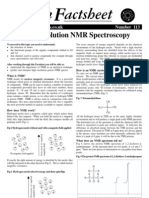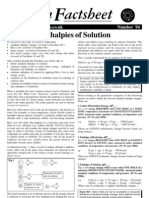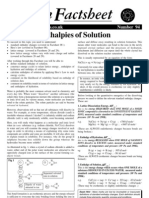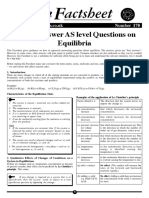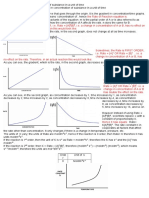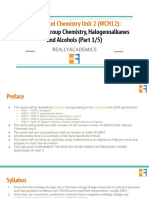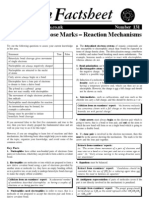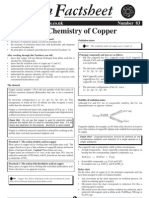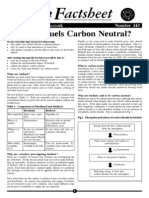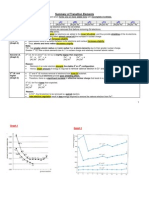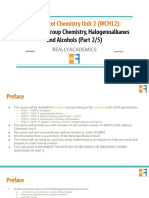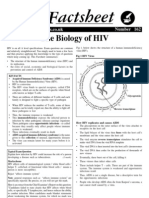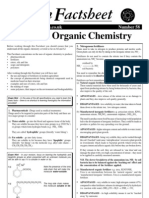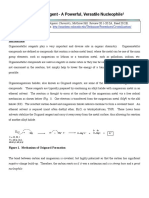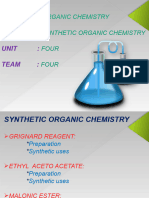Hem Actsheet: Organic Chemistry 2: Halogeno-Compounds and Grignard Reagents
Hem Actsheet: Organic Chemistry 2: Halogeno-Compounds and Grignard Reagents
Uploaded by
kishan_katwaCopyright:
Available Formats
Hem Actsheet: Organic Chemistry 2: Halogeno-Compounds and Grignard Reagents
Hem Actsheet: Organic Chemistry 2: Halogeno-Compounds and Grignard Reagents
Uploaded by
kishan_katwaOriginal Title
Copyright
Available Formats
Share this document
Did you find this document useful?
Is this content inappropriate?
Copyright:
Available Formats
Hem Actsheet: Organic Chemistry 2: Halogeno-Compounds and Grignard Reagents
Hem Actsheet: Organic Chemistry 2: Halogeno-Compounds and Grignard Reagents
Uploaded by
kishan_katwaCopyright:
Available Formats
Chem Factsheet
www.curriculumpress.co.uk April 2002 Number 31 Organic Chemistry 2: Halogeno-compounds and Grignard Reagents
To succeed in this topic you need to: Have a good understanding of AS-level Organic Chemistry (Factsheets 15, 16, 17 and 27); Be confident in using organic nomenclature and structural formulae. After working through this Factsheet you will: Have reviewed the chemistry of the halogeno-compounds covered so far; Know how Grignard reagents are formed; Know how Grignard reagents are used in a variety of organic preparations. Reactions of Grignard reagents The Grignard reagent is very reactive. H CH 3 C H They contain a - carbon, which gives rise to the extremely reactive R species i.e. in the above example, H CH 3 C H alcohol nucleophilic substitution The R species is a strong nucleophile, which is capable of attacking + carbons in other molecules - hence carbon chain lengths can be increased. 1. Reaction with water to form alkanes RMgI + H2O RH + Mg(OH)I Reaction type: Mechanism: Substitution. Nucleophilic.
Mg
Halogeno-alkanes
Fig 1 below summarises the reactions of the halogeno-alkanes. Fig. 1 Halogenoalkane reactions nitrile nucleophilic substitution
KCN in water/ethanol heat under reflux NaOH(aq)
heat under reflux
Halogenoalkane
NH3 in ethanol heat KOH in ethanol heat under reflux
amine nucleophilic substitution
alkene nucleophilic elimination
This reaction shows why Grignard reagents must be prepared in dry conditions. 2. Reaction with methanal to form primary alcohol. Methanal gas is passed into the solution of the Grignard, and the mixture is then hydrolysed with dilute hydrochloric acid. RMgI + CH2=O RCH2OMgI (Nucleophilic addition)
Grignard Reagents
The main focus of this Factsheet is on the formation and use of a commonly examined set of reagents derived from the halogenoalkanes - Grignard reagents. Preparation of Grignard Reagents Grignard reagents are prepared by refluxing alkyl or aryl bromide or iodide compounds, dissolved in dry ether, with small magnesium turnings. RBr + Mg RMgBr 'Grignard reagent'
Then: RCH2OMgI + H2O RCH2OH + Mg(OH)I (Hydrolysis) Reaction conditions: In dry ether, followed by addition of dilute acid for hydrolysis. 3. Reaction with other aldehydes to form secondary alcohols. R R RMgI + R'CHO CHOMgI R'
H 2O
CHOH + Mg(OH)I R'
The Grignard reagent cannot be isolated - it must remain in etheral solution for further reaction. Example of Grignard reagent preparation: C2H5I + Mg C2H5MgI Reaction type: Conditions: Addition Dry ether solvent Reflux Trace of iodine as catalyst
Reaction conditions: In dry ether, followed by addition of dilute acid for hydrolysis. For example: C 2H 5 CH3 C 2H 5 COH + Mg(OH)I CH3 Butan-2-ol
C2H5MgI + CH3CHO CHOMgI H 2O
Halogeno-compounds and Grigand Reagents
Answers. 1. (a) H
Chem Factsheet
www.curriculumpress.co.uk
4. Reaction with ketones to form tertiary alcohols. R1 R1
R1
H C H
Br H C H H C H C H Cl C H Cl C H H H H
RMgI +
R2
C=O RCOMgI R2
H 2O
RCOH + Mg(OH)I R2 (b) H
H C H
Reaction conditions: In dry ether, followed by addition of dilute acid for hydrolysis. For example: C2H5 CH3MgI + C=O C3H 7 C2H5 CH3COMgI C 3H 7 H 2O C2H5 CH3COH + Mg(OH)I C 3H 7 (c)
H H C H
H C H
H H C H
C C H
H Br C Br
Cl C H H
2. Because they contain a very unstable - carbon atom, an extremely strong nucleophile. 3. CH3I should be dissolved in dry ether Magnesium turnings added Iodine catalyst Heat under reflux 4. (a) CH3CH2CH2I Conditions: + Mg CH3CH2CH2MgI
5. Reactions of Grignard with carbon dioxide to form carboxylic acid. Carbon dioxide is bubbled through (or solid CO2, dry ice, is added to) an etheral solution of a Grignard reagent. RMgI + CO2 RCOMgI O
H 2O
Reflux in ether Iodine catalyst
RCOH + Mg(OH)I O
(b) CH3CH2CH2MgI + CO2 + H2O CH3CH2CH2COOH + Mg(OH)I Conditions: 5. (a) CH3CH2Br Conditions: Addition of CO2 in dry ether, then dilute acid for hydrolysis + Mg CH3CH2MgBr
Reaction conditions: In dry ether, followed by addition of dilute acid for hydrolysis. Questions 1. Write the structural formulae of the following compounds: (a) 2-bromopropane (b) 1,2-dichlorobutane (c) 2,2-dibromo-1-chloro-3-methylhexane 2. Explain why Grignard reagents are very reactive. 3. Explain clearly how the Grignard reagent CH3MgI would be formed from CH3I. 4. This question relates to the following reaction scheme: CH3CH2CH2I
step 1
Reflux in ether Iodine catalyst
(b) CH3CH2CH2MgI + CH3CHO + H2O CH3CH2CHOHCH3 + Mg(OH)Br Conditions: Dissolved in dry ether, then dilute acid for hydrolysis.
CH3CH2CH2MgI
step 2
CH3CH2CH2COOH
Give the reaction equations and conditions for: (a) Step 1. (b) Step 2. 5. This question relates to the following reaction scheme: CH3CH2Br
step 1
CH3CH2MgBr
step 2
CH3CH2CHOHCH3
Give the reaction equations and conditions for: (a) Step 1. (b) Step 2.
Acknowledgements: This Factsheet was researched and written by Sam Goodman and Kieron Heath. Curriculum Press, Unit 305B, The Big Peg, 120 Vyse Street, Birmingham, B18 6NF. ChemistryFactsheets may be copied free of charge by teaching staff or students, provided that their school is a registered subscriber. No part of these Factsheets may be reproduced, stored in a retrieval system, or transmitted, in any other form or by any other means, without the prior permission of the publisher. ISSN 1351-5136
You might also like
- Hem Actsheet: Redox Equilibria IV - Redox TitrationsDocument3 pagesHem Actsheet: Redox Equilibria IV - Redox TitrationsAya ZhNo ratings yet
- A227 RuBP CarboxylaseDocument4 pagesA227 RuBP Carboxylaseramloghun veer100% (1)
- 048 Lab Chemistry - Organic PDFDocument3 pages048 Lab Chemistry - Organic PDFSakib AhsanNo ratings yet
- 22kpaDocument4 pages22kpaNidhi SisodiaNo ratings yet
- 69 Trends in Physicalpropsrevised PDFDocument3 pages69 Trends in Physicalpropsrevised PDFThuvarakaNo ratings yet
- 113 NMRDocument4 pages113 NMRAiza Nawaz100% (1)
- 054 Infrared Spectro PDFDocument3 pages054 Infrared Spectro PDFThuvarakaNo ratings yet
- 133 AcylationDocument4 pages133 AcylationAnonymous vRpzQ2BLNo ratings yet
- 70 Trends in PTable2 Chem Revised PDFDocument4 pages70 Trends in PTable2 Chem Revised PDFsammam mahdi samiNo ratings yet
- Hem Actsheet: Organic Chemistry 4: Carbonyl CompoundsDocument3 pagesHem Actsheet: Organic Chemistry 4: Carbonyl CompoundsDaniel C. WalshNo ratings yet
- Reacciones Caracteristicas Por Grupos FuncionalesDocument3 pagesReacciones Caracteristicas Por Grupos FuncionalesAdelitza StrubingerNo ratings yet
- Hem Actsheet: Answering Questions On Electrochemical CellsDocument2 pagesHem Actsheet: Answering Questions On Electrochemical CellsAbdul AzizNo ratings yet
- 94 Enthalpies of SolutionDocument4 pages94 Enthalpies of SolutionJude PeelNo ratings yet
- Enthalpies of SolutionDocument4 pagesEnthalpies of SolutionNana_Banana_940% (1)
- Mass SpectrosDocument4 pagesMass SpectrosManrajSingh100% (2)
- Oxidation and Reduction in Organic Chemistry: Number 97 WWW - Curriculum-Press - Co.ukDocument5 pagesOxidation and Reduction in Organic Chemistry: Number 97 WWW - Curriculum-Press - Co.ukKirsty McCulloughNo ratings yet
- 32 Organ PDFDocument3 pages32 Organ PDFThuvarakaNo ratings yet
- 11oxida PDFDocument3 pages11oxida PDFThuvarakaNo ratings yet
- 173 The Chemistry of BreathalysersDocument3 pages173 The Chemistry of BreathalysersM DiNo ratings yet
- Maths For Chemists 1Document3 pagesMaths For Chemists 1Suprateeka TalukderNo ratings yet
- 170 How To Answer As Level Questions On EquilibraDocument4 pages170 How To Answer As Level Questions On EquilibraM DiNo ratings yet
- 34 Org N CompoundsDocument2 pages34 Org N CompoundsBotagoz Kaukenova100% (1)
- Summary of Organic TestDocument2 pagesSummary of Organic TestritmrazNo ratings yet
- Standard Electrode Potentials & CellsDocument3 pagesStandard Electrode Potentials & Cellsmy nameNo ratings yet
- 16 Organ PDFDocument3 pages16 Organ PDFAya ZhNo ratings yet
- Answering Questions On Redox Titrations I: Number 57 WWW - Curriculumpress.co - UkDocument3 pagesAnswering Questions On Redox Titrations I: Number 57 WWW - Curriculumpress.co - UkWeb BooksNo ratings yet
- Reactividad Del BencenoDocument3 pagesReactividad Del BencenoRoberto GoncalvesNo ratings yet
- Chem Factsheet 17Document3 pagesChem Factsheet 17drdre12100% (1)
- 05 Bondi PDFDocument4 pages05 Bondi PDFThuvarakaNo ratings yet
- Transition Metals 2Document2 pagesTransition Metals 2TheDhruvyadavNo ratings yet
- Answering Questions On Born-Haber Cycles: January 2002 Number 29Document3 pagesAnswering Questions On Born-Haber Cycles: January 2002 Number 29Nidhi SisodiaNo ratings yet
- 046 Transition Metals 2 No Answer Chen Fact SheetDocument2 pages046 Transition Metals 2 No Answer Chen Fact SheetlicciNo ratings yet
- AQA A Level Chemistry Unit 4 NotesDocument29 pagesAQA A Level Chemistry Unit 4 NotesMuadh Chati100% (2)
- Edexcel - IAS - Organic Chemistry - 1Document21 pagesEdexcel - IAS - Organic Chemistry - 1mostafa barakatNo ratings yet
- Chemistry Unit 2 Part 1 ReallyacademicsDocument42 pagesChemistry Unit 2 Part 1 ReallyacademicsWill AndyNo ratings yet
- C IndexDocument17 pagesC IndexalvinkoyNo ratings yet
- Why Students Lose Marks - Reaction Mechanisms: Number 131 WWW - Curriculum-Press - Co.ukDocument4 pagesWhy Students Lose Marks - Reaction Mechanisms: Number 131 WWW - Curriculum-Press - Co.ukAmelia AkandeNo ratings yet
- 77 Hydrogen BondingDocument3 pages77 Hydrogen Bondingadeganiyou100% (1)
- The Chemistry of Copper: Number 83 WWW - Curriculum-Press - Co.ukDocument5 pagesThe Chemistry of Copper: Number 83 WWW - Curriculum-Press - Co.uks7076728g100% (1)
- Enthalpy Changes and Hess CyclesDocument17 pagesEnthalpy Changes and Hess CyclesMoon Kim100% (1)
- 042 Critical Analys Experi PDFDocument2 pages042 Critical Analys Experi PDFThuvarakaNo ratings yet
- 20 - Periodic Table - Group 4Document3 pages20 - Periodic Table - Group 4winnielong100% (1)
- 143 Are Biofuels Carbon NeutralDocument2 pages143 Are Biofuels Carbon NeutralSan SiddzNo ratings yet
- Edexcel Chemistry Unit 2 Revision.Document47 pagesEdexcel Chemistry Unit 2 Revision.NizŏǾŏ Wait For-it Ismail100% (2)
- H2 Chem Summary of Transition ElementDocument7 pagesH2 Chem Summary of Transition Elementonnoez100% (2)
- Chemistry Unit 2 Part 2 ReallyacademicsDocument26 pagesChemistry Unit 2 Part 2 ReallyacademicsWill Andy100% (1)
- Bio Factsheet: The Paired T-Test & When To Use ItDocument3 pagesBio Factsheet: The Paired T-Test & When To Use ItjayNo ratings yet
- Chemistry Unit 4 Part 1 ReallyacademicsDocument41 pagesChemistry Unit 4 Part 1 ReallyacademicsWill AndyNo ratings yet
- 162 Biology of HIVv2Document3 pages162 Biology of HIVv2gert16No ratings yet
- Applied Organic ChemistryDocument2 pagesApplied Organic ChemistrycliffmusicgirlNo ratings yet
- Practice Makes Perfect in Chemistry: Kinetics and Equilibrium with AnswersFrom EverandPractice Makes Perfect in Chemistry: Kinetics and Equilibrium with AnswersNo ratings yet
- O Level Chemistry Structured Practice Papers 9From EverandO Level Chemistry Structured Practice Papers 9Rating: 5 out of 5 stars5/5 (1)
- Organometallic Transition Metal Catalysis: A Holistic Approach to Understanding and Predicting their MechanismsFrom EverandOrganometallic Transition Metal Catalysis: A Holistic Approach to Understanding and Predicting their MechanismsNo ratings yet
- 5-Grignard Benzophenone Methyl Benzoate and CO2 Sp17Document13 pages5-Grignard Benzophenone Methyl Benzoate and CO2 Sp17yugawad0% (1)
- Exp 16Document19 pagesExp 16Online tutorNo ratings yet
- Team 4Document66 pagesTeam 4RameshbabuNo ratings yet
- Grignard Reaction 3Document15 pagesGrignard Reaction 3Hamed IjazNo ratings yet







